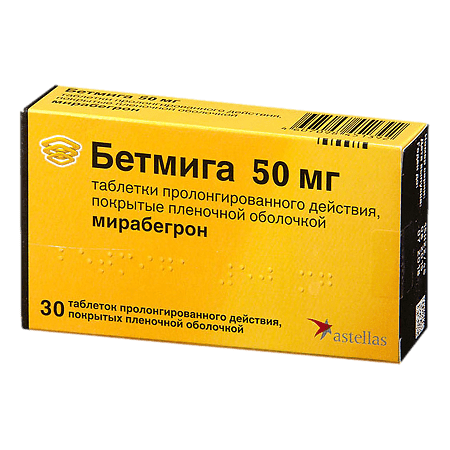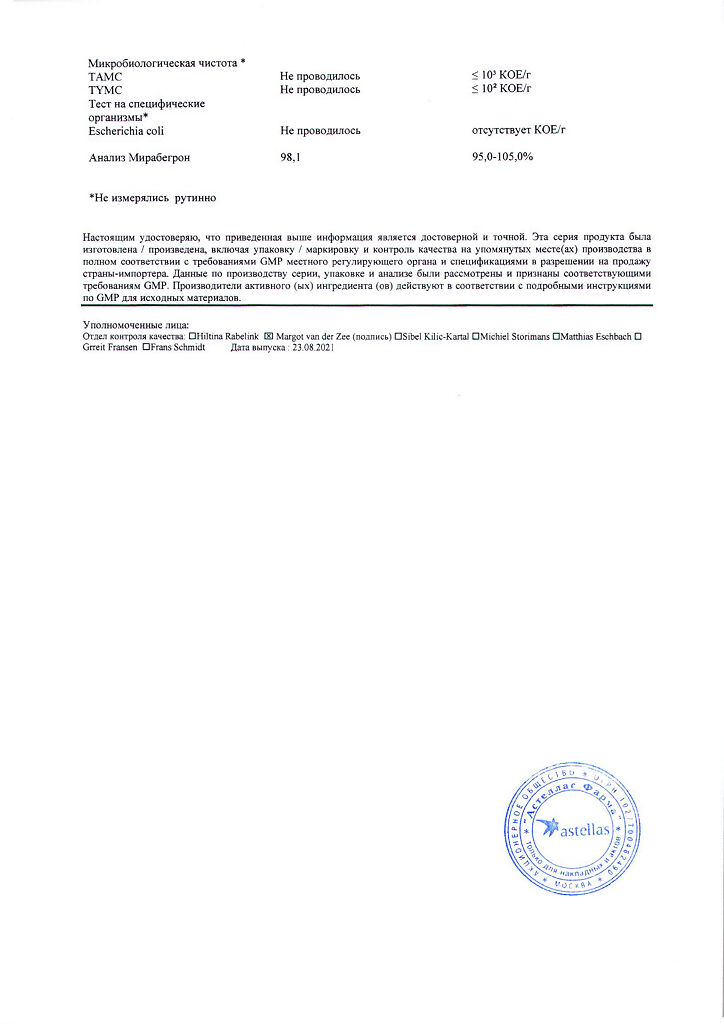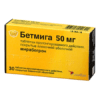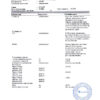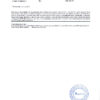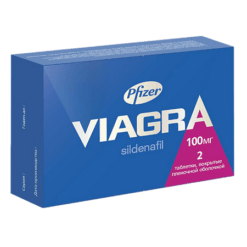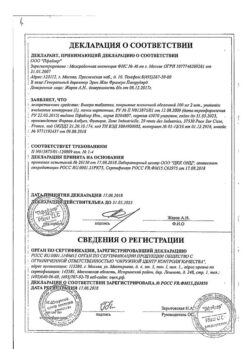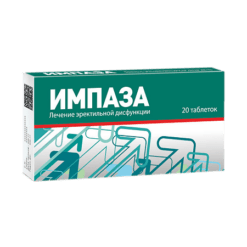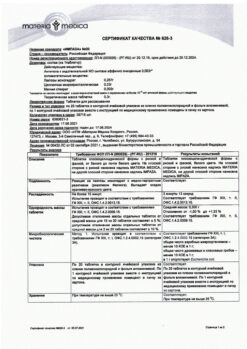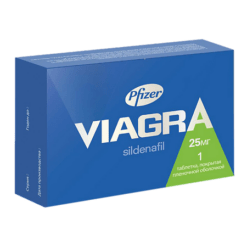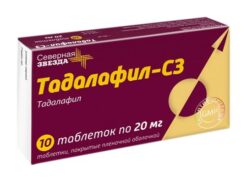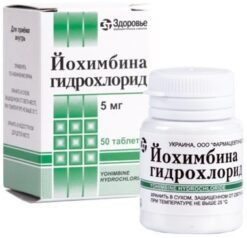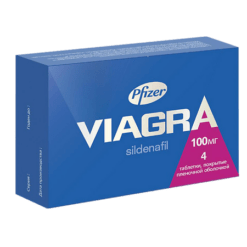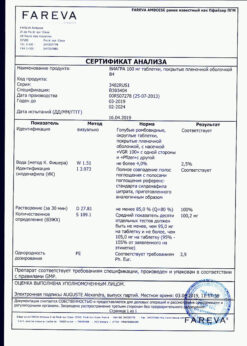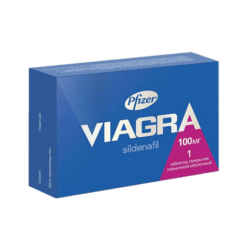No products in the cart.
Betmiga, 50 mg 30 pcs.
€61.88 €53.63
Description
A selective β3-adrenoreceptor agonist. Studies with mirabegron demonstrated relaxation of bladder smooth muscles in rats and in an isolated preparation of human tissues, as well as an increase in the concentration of cAMP in the bladder tissue in rats. Thus, mirabegron improves the reservoir function of the bladder by stimulating β3-adrenoreceptors located in its wall.
Studies have demonstrated the efficacy of mirabegron both in patients previously treated with m-cholinoblockers for the treatment of overactive bladder (UBG) and in patients without a history of prior therapy with m-cholinoblockers.
Mirabegron has also been effective in patients with UBG who have stopped treatment with m-cholinoblockers due to lack of effect.
A 12-week study in men with lower urinary tract symptoms (LUTs) and infravesical obstruction (IVO) demonstrated the safety and good tolerability of mirabegron at doses of 50 and 100 mg once daily, as well as no effect of mirabegron on cystometric parameters.
Changes in pulse rate and BP during treatment are reversible and disappear after discontinuation.
Pharmacokinetics
After oral administration mirabegron is absorbed into the bloodstream and reaches Cmax in plasma between three and four hours after administration. Studies have shown an increase in absolute bioavailability from 29% to 35% after increasing the dose from 25 to 50 mg.
The mean Cmax value and AUC value increased more than proportionally to the dose. Css is reached after 7 days of taking mirabegron once daily. The plasma Css of mirabegron is approximately 2 times greater after multiple doses of once daily.
Mirabegron is intensively distributed in the body. Vd under stable conditions (Vss) is approximately 1670 l. Mirabegron binds (approximately 71%) to plasma proteins and also exhibits moderate affinity to albumin and alpha-1 acidic glycoprotein.
Mirabegron distributes to erythrocytes. Concentrations of 14C mirabegron in erythrocytes were 2 times higher than in plasma (as shown by in vitro studies).
There are many pathways for metabolism of mirabegron in the body, including dealkylation, oxidation, (direct) glucuronidation and amide hydrolysis. After a single administration of C-mirabegron, the main circulating component is mirabegron.
Two major metabolites of mirabegron were detected in human plasma: both are glucuronides (phase II metabolites) and constitute, respectively, 16% and 11% of the total drug concentration. These metabolites have no pharmacological activity.
Despite the participation of the CYP2D6 and CYP3A4 isoenzymes in the oxidative metabolic pathway of mirabegron under in vitro conditions, under in vivo conditions the role of these isoenzymes in total elimination is small.
Total plasma clearance is approximately 57 L/h. The final T1/2 is approximately 50 hr. Renal clearance is approximately 13 l/h, which corresponds to almost 25% of the total clearance. The main mechanisms of excretion by the kidneys are active tubular secretion and glomerular filtration.
The amount of unchanged mirabegron excreted in the urine is dose-dependent and ranges from 6.0% after a daily dose of 25 mg to 12.2% after a daily dose of 100 mg. After administration of 160 mg of C-mirabegron by healthy volunteers, approximately 55% of the radiolabel was detected in the urine and 34% in the feces. The fraction of unchanged mirabegron was approximately 45% of the total isotope-labeled drug in the urine, indicating the presence of metabolites. Most of the isotope-labeled drug in feces was unchanged mirabegron.
Indications
Indications
Active ingredient
Active ingredient
Composition
Composition
How to take, the dosage
How to take, the dosage
Adults (≥18 years), including the elderly:
50 mg once daily orally with fluids, regardless of the time of meals.
The Betmig tablet must be taken whole and should not be chewed, as this may affect the prolonged release of the active ingredient.
Interaction
Interaction
Special Instructions
Special Instructions
Mirabegron at therapeutic doses has not demonstrated clinically significant QT interval prolongation in studies.
Contraindications
Contraindications
Side effects
Side effects
Infections and invasions: often – urinary tract infection; infrequently – vaginal infection, cystitis.
An organ of vision: rarely – eyelid edema.
The cardiovascular system: frequently – tachycardia; infrequently – palpitations, atrial fibrillation, increased BP
The digestive system: frequently – nausea; infrequently – dyspepsia, gastritis, increased GGT, AST, ALT activity; rarely – lip edema.
Skin and subcutaneous tissue: infrequent – urticaria, rash, macular rash, papular rash, pruritus; rarely – leukocystoclastic vasculitis, purpura, angioedema.
Muscular system disorders: infrequent – swelling of joints.
Reproductive system disorders: infrequent – vulvovaginal itching
*Discovered during post-marketing use.
Overdose
Overdose
Symptoms:
When mirabegron was administered once to healthy volunteers, doses up to 400 mg were used. When such dose levels were used, adverse events in the form of palpitations (in 1 of 6 volunteers) and increased heart rate over 100 bpm (in 3 of 6 volunteers) were recorded. Multiple daily doses of up to 300 mg in healthy volunteers showed increased pulse rate and systolic blood pressure (for 10 days).
Treatment: symptomatic and supportive therapy. Monitoring of pulse rate, blood pressure and ECG is necessary.
Pregnancy use
Pregnancy use
Pregnancy
There are limited data on the use of mirabegron in pregnant women. Animal studies have shown reproductive toxicity. Mirabegron is not recommended during pregnancy and in women of childbearing age who are not using contraception.
Breastfeeding
In rodents, mirabegron is excreted with breast milk; therefore, in humans there is also a risk of the drug entering breast milk. There are no studies on the effects of mirabegron on breast milk production, excretion of mirabegron with breast milk, or effects on the child. Mirabegron should not be used in women during breastfeeding.
Fertility
In animal studies, no effect of mirabegron on fertility in non-lethal doses has been found.
It has not been determined whether mirabegron affects fertility in humans.
Additional information
| Manufacturer | Avara Pharmaceutical Technologies Inc, USA |
|---|---|
| Medication form | slow-release tablets |
| Brand | Avara Pharmaceutical Technologies Inc |
Related products
Buy Betmiga, 50 mg 30 pcs. with delivery to USA, UK, Europe and over 120 other countries.

